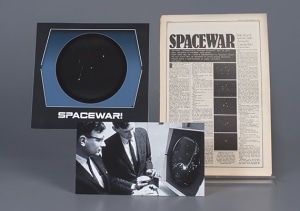“It’s the most wonderful time of the year!”
Well, almost. Christmas still wins out for me, but this is a close second. And not just because May brings with it Star Wars Day (May the Fourth be with you!) but because it’s time for the World Video Game Hall of Game inductions!
This is our fourth year honoring the best the gaming industry has to offer, based on criteria that includes icon-status, longevity, geographic reach, and cultural influence. This year, four new games joined ranks that include titles such as Super Mario Bros., Pac-Man, and Halo: Combat Evolved. These games may seem disparate, but they all have one thing in common: The gaming industry was never the same after their publication.
“What’s the first video game?”
I’m constantly asked that question, and oddly enough, there’s no one, simple answer. But Spacewar! is always one of the titles I offer in response. Designed in 1962 by Steve “Slug” Russell and fellow members of the Massachusetts Institute of Technology Tech Model Railroad Club, Spacewar! featured two dueling spaceships locked in cosmic combat, firing torpedoes while circling a star whose gravitational pull threatened instant destruction. Programmed on a DEC PDP-1 minicomputer (which, despite the name, was anything but small), the game was inspired both by popular science-fiction novels and the real-world competition between the United States and the Soviet Union for control of the final frontier of space.
While students initially snuck into the computer lab to play the game during off hours, it slowly but surely spread from computer center to computer center, both in the U.S. and abroad. It even inspired the very first piece of video game journalism when writer Stewart Brand teamed with photographer Annie Leibovitz for an article in Rolling Stone magazine in 1972. Perhaps most importantly, the game inspired a young engineer named Nolan Bushnell to develop his own arcade version of the game called Computer Space. Though this eye-catching—but rather confusing—remake didn’t sell well, Bushnell continued his developments, eventually founding Atari, Inc. and creating the first successful arcade game, Pong.
Most of us never played Spacewar! except perhaps on an emulator, but its influence on the nascent video game industry is impossible to ignore. As Brand said in Rolling Stone, it was “a flawless crystal ball of things to come in computer science and computer use.”
So I’ll admit it. I’m not a huge fan of “sportsball,” as I like to call the genre as a whole. But guess what one of the largest segments of video game sales relates to? That’s right, sports. And there’s no denying that John Madden Football is the granddaddy of them all.
Electronic Arts (EA) redefined modern sports video games with its 1990 reboot of John Madden Football for the Sega Genesis. Previously, all football games (including the original 1988 John Madden Football for the Apple II) emphasized statistical modeling of games, not the action of individual plays. This reboot transformed the series, focusing on individual confrontations between players, and its top-down view from behind the quarterback placed game players closer to the action than ever before. The game also placed more focus on individual player skill ratings such as speed, strength, and agility.
Fans began eagerly awaiting the game’s annual updates and releases. The 1992 edition of the game included an official National Football League license which allowed EA to use real teams, uniforms, and logos, and three years later a license with the NFL Players Association added actual players’ names and likenesses to the game. At the same time, the game has influenced real-life football as well. ESPN’s “skycam” technology provides broadcasters with a camera angle almost identical to the top-down, behind-the-quarterback perspective established by Madden. And despite being a Super Bowl-winning coach and preeminent television commentator, John Madden himself is now more synonymous with video games than with professional football.
Madden’s success led to the release of other annually released, action-oriented sports franchises, such as the FIFA soccer and NBA 2K basketball series, and plenty of fans purchase new consoles just to keep up with the latest releases in their favorite sports. Without Madden, the sports scene would look very different in today’s gaming world.
Sometimes being the first at something doesn’t automatically make you the best, and this was the case with Core Design’s Tomb Raider. Published in 1996, it was far from the first action-adventure game. But when you pair that with revolutionary graphics, creative gameplay that pulled from some of the best genres of its time, and a breakout main character, you might find yourself striking gold. Literally.
Inspired by Hollywood blockbusters like Raiders of the Lost Ark, precision-based platforming and puzzle-solving computer games such as Prince of Persia, and actual archaeological discoveries of interlocking room structures found in the tomb of King Tutankhamun, developers created a cinematic, multi-leveled three-dimensional environment that allowed players to jump, climb, slide, and swim their way across the game.
While the game’s unique technical elements would have been enough to appeal to gamers, it was the main character, Lara Croft, who helped catapult Tomb Raider to wide-range stardom. Styled as a female Indiana Jones, Lara’s tough persona and no-nonsense attitude propelled a female main character to a popularity virtually unseen before in the gaming world. Though not without controversy, due to over-stated sex appeal and skimpy clothing, Lara is still hailed as a breakthrough for proving that a female character could head a successful video game franchise. Her popularity only grew after Angeline Jolie’s portrayal of the character in the 2001 film Lara Croft: Tomb Raider, and the Guinness World Records cite her as the “most recognized female video game character.”
Having evolved into an even stronger female role model with more realistic body proportions, Lara Croft is still leading the Tomb Raider franchise with a successful reboot of the series, as well as a new feature film.
When you have the word “Final” in your title, you don’t really expect a number “seven” to follow it. It’s kind of an oxymoron. But, that never seemed to be a problem for this particular game.
In 1987, developer Square released a role-playing game called Final Fantasy, which allowed players to control the Four Warriors of Light in their journey to save the world from destruction. For the next 10 years, the Final Fantasy series enjoyed critical success, but the Japanese RPG genre was still relatively niche in the rest of the world. That changed in 1997 when a spikey-haired mercenary and a corrupt one-winged angel blasted onto the international scene.
Final Fantasy VII experienced a multitude of alterations before its publication, beginning development on the Super Famicom home console, then moving to the Japanese-only release of the Nintendo 64 disk drive peripheral. But the rising cost of cartridges, cutting-edge 3-D graphics, and elaborate full-motion video cut-scenes that produced disappointingly low frame rates led developers to consider the new CD-ROM technology offered by Sony and its recently unveiled PlayStation. As one of the largest and most expensive games its era, Square quickly saw advantages to the switch, as the game would have resulted in a whopping 30 N64 disks, while Sony could produce it on a mere three CD-ROMs.
Perhaps most importantly, FFVII is acclaimed as the game that broke Japanese RPG games into worldwide mainstream popularity. Together, Sony and Square launched a $30-million advertising campaign in conjunction with DC, Marvel, and Pepsi. This vast media blitz paid off, and the demand for the game soared so high that many American retailers began selling it before the official release date. The game eventually sold more than 10 million copies worldwide, making its sales the second highest among games sold for the original PlayStation.
In 2015, Sony and Square brought an audience to its feet during the E3 conference by announcing a long sought-after high-definition remake of the game. And with many players still lauding it as one of the best video games of all time, FFVII has proven that it’s anything but final!
So there you have it, the 2018 inductees to the World Video Game Hall of Fame. If your favorite hasn’t already made the list be sure to let us know. Nominations for 2019 are already open, and I can’t wait to see who will join us next!







